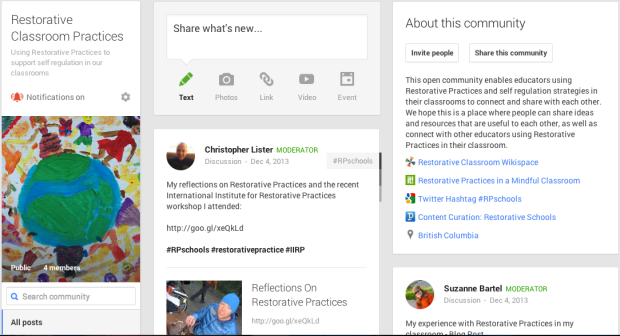Here is an overview of Suzanne Bartel and Christopher Lister’s joint EDCI 338 Professional Learning Project about Restorative Practices including Self Regulation.
Project Goal
Our original goal was to create an online place for educators who are interested in using Restorative Practices in their classrooms to connect and share experiences. Our plan was to take our existing Restorative Classroom Circles Wikispace and give it a facelift by adding the Restorative Practices philosophies, Compass of Shame, and the Social Discipline Window. We also planned to engage our current Wikispace members and attract new members from our Twitter networks and local school district colleagues. With our existing restorative methods, we wanted to include more social and emotional learning into our curriculum. We planned to introduce new concepts such as self-regulation (MindUP curriculum) into the Wikispace as a complementary addition to classroom circles.
Adaptations of our Goal: The Learning is in the Journey, not the Project
This morning, we read a tweet from Mardelle Sauerborn that said “Cool how the projects are secondary to the journey.” We couldn’t sum it up better ourselves! Throughout our journey on this project, we have been constantly growing and learning in our EDCI #338 class discussions, school district collaboration group, Restorative Practices workshop, and our personal experiences with Restorative Practices in our classrooms.
After creating a polldaddy survey to elicit feedback from our Wikispace members and talking to colleagues already using Restorative Practices in their classrooms, we realized that we were not having much success using our Wikispace as a collaborative tool. We started to wonder if we were using the right platform to create a collaborative environment. In one of our EDCI 338 sharing classes, we were introduced to the idea of building a Google+ Community from Jane Rees and Allison Galloway. This platform meant that people could participate in our community without becoming a member. They could also add their own content and participate in online conversations. At this point, we decided that our Wikispace might be best left as a resource for implementing Restorative Practices, and a Google+ Community could be used to encourage collaboration.
One interesting part of our learning journey occurred when we tried to deepen our understanding of Restorative Practices. Several Google searches for “restorative practices” returned little useful information outside of International Institute for Restorative Practices. We knew there was content out there but we had difficulty finding it. Our original plan was use Diigo has a tool to collect and share bookmarks on the topic. We attended a Hangout on Diigo hosted by Ed Tech Mentors Network and found that although it is a useful tool, it is limited in its ability to generate and evaluate content in the same that specific curation tools like Paper.li, Pearl Trees, and Scoop.it can. We really liked the magazine style layout and ease of use that Scoop.it offered.
Actions Taken:
-
Created a polldaddy to seek feedback on our current Wiki – Feedback Survey
-
Attended Hangout on Diigo hosted by Ed Tech Mentors Network
-
Content Curation via Scoop.it
-
Collaborating with colleagues:
-
Created hashtag on Twitter #RPschools
-
Created a Google+ Community – Restorative Classroom Practices
-
Attended monthly school district Restorative Practices teacher collaboration meetings
-
Attended 2-day Restorative Practices workshop in Coquitlam, B.C. hosted by International Institute of Restorative Practices (IIRP)
-
-
Restorative Classroom Practices Wikispace Updates:
-
Implemented feedback from poll
-
Included mindup/self regulations strategies
-
Further Extensions to Project
-
After attending our Restorative Practices workshop, we realized the importance of explicitly teaching students the restorative process through storytelling. We plan on creating a simple restorative storybook, embedding into our community, and potentially creating an electronic copy to be published on iTunes. Thanks to the expertise of Liane and Michelle
-
Continue to build Google + Community Restorative Classroom Practices by
-
Maintain curation on Restorative Practices in a Mindful Classroom
